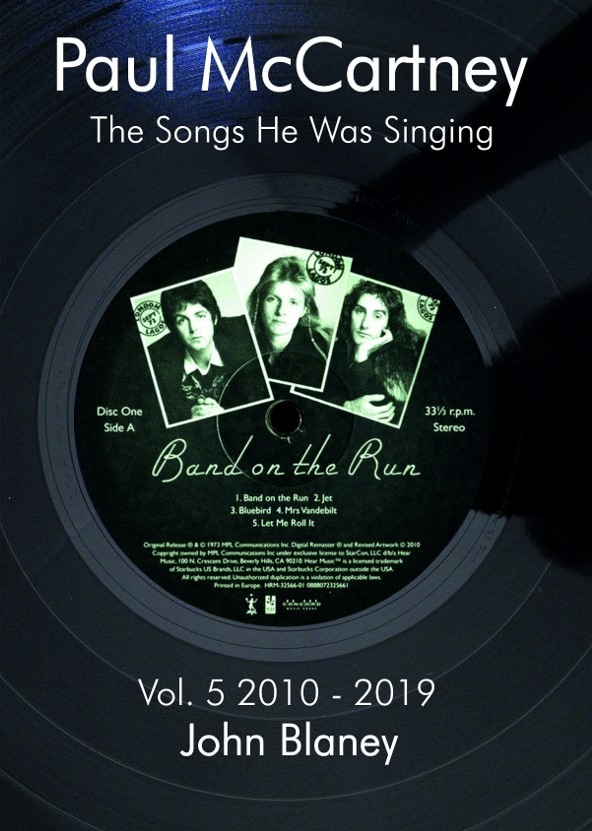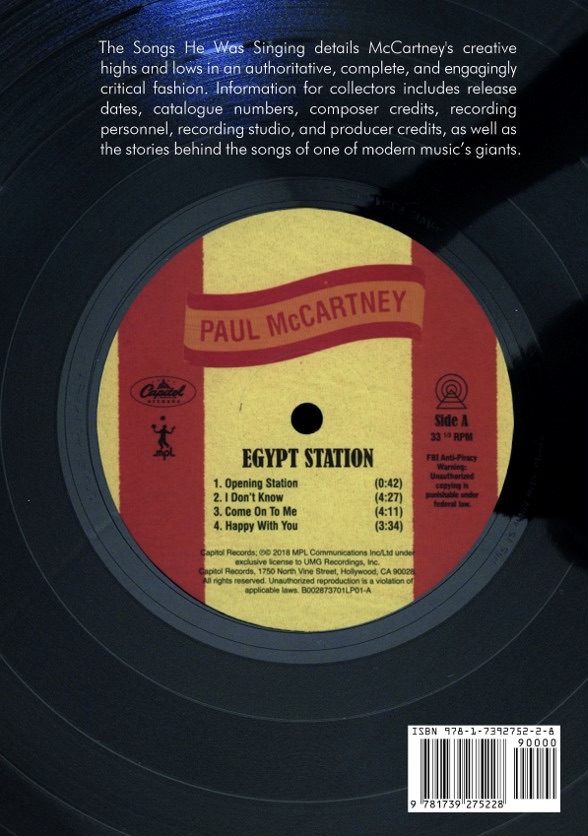If you’re a completist and want to cross check that you have every physical and digital release, or if you’re interested in a smart, informed commentary on every song by Paul McCartney then this book series is for you.
Paul McCartney The Songs He Was Singing Vol. 5 2010 – 2019 is (as its title suggests) the latest installment in a series compiled and written by John Blaney. Blaney, a passionate Beatle fan, brings to his writing the expertise and rigour of a professional historian. After starting out in music retail he trained as a graphic designer and studied History Of Art at Camberwell College Of Arts and at Goldsmith College (both in London) before taking up his present post as the curator of a museum of technology. He’s the author and publisher of no less than twelve books on The Beatles, Paul McCartney, John Lennon and George Harrison.
In The Songs He Was Singing series Blaney has split McCartney’s songwriting and his steady release schedule roughly into ten-year slabs, with Volume 1 covering the period 1967-1979; Volume 2 the 1980’s; Volume 3 the 1990’s; and Volume 4 the Noughties (i.e. the years 2000-2009).
And that brings us to the present book (due out next month) and the years 2010 – 2019. Or, to put it another way, from the re-release of Band On The Run – the very first in the Archive Collection series – through to the bloated Egypt Station (Traveller’s Edition).
The way Blaney has structured the content in this series is comprehensive – with just a couple of caveats. For each entry you get US and UK release dates and chart positions, then the name of each song, the personnel who played, and recording locations. If it’s not a re-issue (or, if it’s a previously unreleased bonus track) you get an individual song description and an appraisal by Blaney. Then there’s a concluding “Data” section for each release detailing correctly and succinctly exactly how it was issued i.e. which formats (LP, CD, digital), along with the sometimes complex configurations and extras the release came in. This includes if promo copies were produced and distributed. It is great book for identifying those rarities which may have escaped your attention. A good example of this is the “Tug Of War Data” section where Blaney explains the more obscure extras. Like for example the Barnes and Noble-only 7″ bonus single ‘Ebony and Ivory’/’Rain Clouds’, released exclusively to their customers in a replica picture sleeve; or the fact that there was a very limited Super Deluxe Edition of the Tug Of War box set issued in a red acrylic slipcase with exclusive hand-numbered 8×10 photo prints. It’s detail like this the avid collector sometimes forgets. Then, for each release, there’s a selection of colour photographs of the packaging and labels to help further identify what you have – or what you might be still be seeking out for your own collection.
The album summaries and individual song descriptions which Blaney provides are worth a special mention – especially for their often outspoken honest opinions. It’s clear that while he reveres the McCartney canon, Blaney is no fanboy who treats everything McCartney touches as brilliant art. If there’s something he feels isn’t up to scratch he has no qualms in saying so. Take this example from the Archive Collection edition of McCartney II. Blaney is addressing one of the included bonus tracks, ‘Mr H Atom’/’You Know I’ll Get You Baby’:
“Not so much a song as a chorus in search of a verse, ‘Mr H Atom’ sounds like a demo recorded by an obscure New Wave band fronted by a female singer – Linda McCartney. Another example of McCartney being unable to flesh out his original idea, ‘Mr H Atom’ is little more than an unfinished fragment. If McCartney had the will to finish the song it may have developed into something a little more interesting. As it stands it’s of passing interest but no contender as a lost gem. ‘You Know I’ll Get You Baby’ is, if anything, less interesting. Consisting of the title repeated over a chugging 12-bar, it may possibly be the worst ‘song’ McCartney has allowed to slip out of his archives.”
Ouch.
Now to a couple of items missing from the book and, to be fair here, what we were sent for review is an early “proof” copy, so there could still be some changes prior to it’s October release. We think the 12 track Paul McCartney Live in Los Angeles should have been included. Yes, it was a free CD given away in 2010 to buyers of the UK newspaper The Mail on Sunday (and also The Irish Mail on Sunday), and it is related to a four-song EP called Amoeba’s Secret officially released on CD and 12″ single by Hear Music in 2007 and 2009 (so it my well have been detailed in a previous volume), but it was the first release of 9 previously unavailable live tracks. Having said all that, Blaney provides at the back of the book a separate section listing all the release dates, record company information, catalogue numbers, etc. Mentioned there briefly is the 2019, 2 x LP, 21 track Amoeba Gig album (also available on CD). But the Mail on Sunday release is different.
There’s also no mention of the 2011 CD re-issue of The Family Way original soundtrack on the Varese Sarabande label. Nor the 2015 vinyl LP of the same title. Again, these may have been dealt with in Volume 1 as the original did come out in 1967.
This volume does give a good amount of space (including some handy photographs) to the12″ EP Hope for the Future from 2015. This contains music McCartney composed for the Bungie online video game Destiny. It even references the very obscure (and rare) secret Record Store Day 12″ ‘Sweet Thrash’ single mix of the song. But it misses an important reference to a 6-LP release called The Music of Destiny Volume I containing the Destiny original soundtrack with many McCartney co-compositions, and a piece titled Music of the Spheres which ends with a movement called ‘The Hope’ that includes his ‘Hope For The Future (Main Version)’.
Having said that some items are missing, in all fairness these are minor and there is plenty here that will be a revelation – even to avid collectors. For us there was numerous releases included we hadn’t been aware of at all. For example in 2011 McCartney and his company MPL helped put together a compilation CD and LP of Buddy Holly cover versions. Rave On Buddy Holly has contributions from the likes of Modest Mouse, Florence and the Machine, Patti Smith, Nick Lowe, and Lou Reed. It also contains Paul McCartney singing a strange, rocky, distorted version of ‘It’s So Easy’. We also learn there was a different digital download only version of the same song sung in a more traditional Holly fashion. Of the CD version Blaney writes “…while McCartney delivers a passionate vocal, the backing is more than a little sloppy and sounds for all the world like a first run through…..And quite why [he] felt compelled to burst into an improvised rap before the track returns for a brief reprise is beyond me…..the result is like watching your dad dancing at a wedding: embarrassing.” When a song is great it gets praised in this book, but if it’s lacking then that gets called out as well – which is kind of refreshing.
Overall, this book is a delight to read, dip into, and is a great resource to cross-check your own collection. John Blaney has done a power of work in researching and engagingly critiquing (almost) every release by Paul McCartney between the years 2010 – 2019. Well worth having in your library.
Now all I need to do is track down the four previous volumes!


